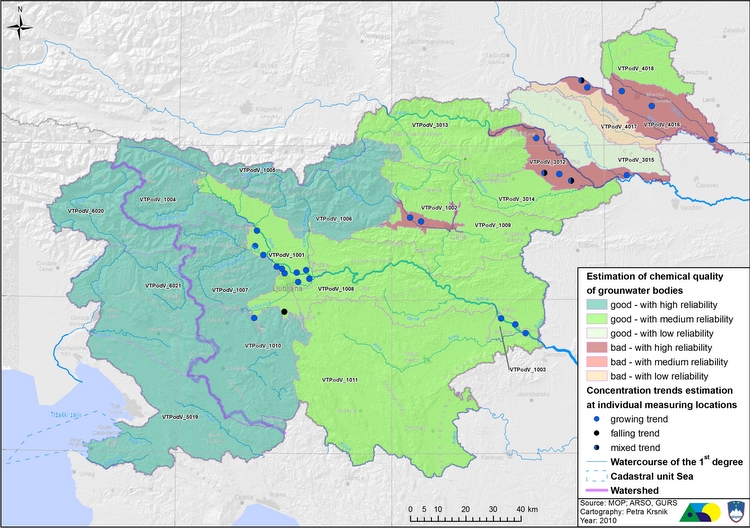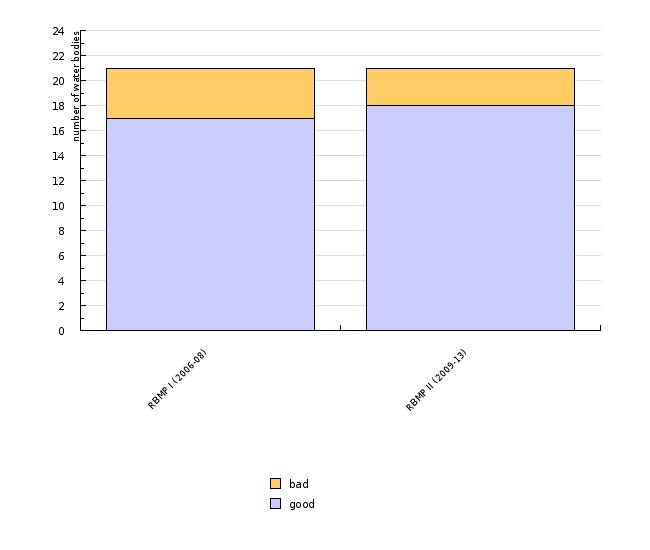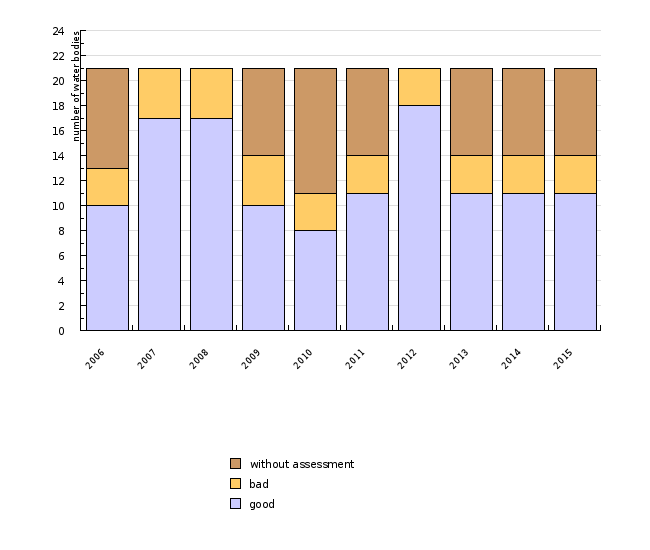[VD11] Groundwater quality

Key message

Average levels of nitrate and orthophosphate in rivers are above the natural background values and do not show significant changes in the observed period. Average values of biochemical oxygen demand and ammonia concentration in rivers in the observed period have been decreasing. The decrease is in accordance with the increase in the percentage of the population connected to municipal and common wastewater treatment plants.
Definition
In Slovenia, groundwater is the most important source of drinking water, providing a water supply to more than 95% of the population. Approximately one third of groundwater that is extracted for the drinking water supply is of sufficient quality that it can be supplied to customers without being treated. Pollutant-free natural groundwater is the most suitable for human consumption. Therefore, the quality of groundwater is important to both the environment and the health of the population.
This indicator presents the assessment of the chemical state of groundwater in Slovenia. Based on the monitoring data, the chemical state of groundwater bodies is assessed every year, while assessments in six-year water management reporting periods are also conducted. Upward or downward trends in measured values of chemical parameters are monitored as well.
An aquifer is an underground layer of water-bearing permeable rock in which substantial quantities of groundwater are accumulated and transmitted. Two prevailing types of aquifers exist in Slovenia: aquifers with intergranular porosity in the flat, lower parts of river valleys and aquifers with karst and fracture porosity. Where the same groundwater body includes both types of aquifers, it is classified as an aquifer with combined-type porosity. A groundwater body is defined as groundwater in one or several adjacent aquifers. In Slovenia, 21 groundwater bodies have been determined by the Rules on determining water bodies of groundwater (Official Gazette of the Republic of Slovenia, No. 63/2005).
The chemical state of a groundwater body is determined in accordance with two EC Directives (Water Framework Directive 2000/60/EC and the Directive on the protection of groundwater against pollution and deterioration, 2006/118/EC) Slovenian regulations (Decree on groundwater status, Official Gazette of the Republic of Slovenia, Nos. 25/2009, 68/2012) and the Methodology for assessing the state of groundwater bodies (www.mop.gov.si). All data obtained through national groundwater monitoring is processed using statistical methods. In addition, the impact of polluted groundwater on the state of surface water, co-depended terrestrial and aquatic ecosystems and the level of drinking water treatment is assessed. Eventual intrusions of salt water or other polluted water are subject to assessment as well.
The chemical state of a groundwater body is assessed to be good when the average values of the parameters are below or equal to the standard or threshold values. Otherwise, the extent of groundwater pollution is determined. When one or more parameters are exceeded, chemical state is assessed to be good if the extent of pollution does not exceed 30% of a groundwater body and if the state of co-dependent surface waters or terrestrial and aquatic ecosystems does not deteriorate. Also, the pollution must not result in the necessity for an increased level of treatment of the drinking water. Otherwise, the chemical state of a groundwater body is assessed to be poor.
Reliability of the assessment is shown by the confidence level attributed to the assessment. A high confidence level means that the assessment is reliable. Medium and low confidence levels mean that additional measurements and the expansion of the measurement sites network will be required to properly confirm the assessment. For this purpose, the measurement network was expanded in 2014 and 2015 when new hydrological stations were build in the framework of the BOBER project. The stations were built on water bodies exposed to above-average levels of pollution.
Charts
Standardised Database for Water Quality Monitoring, Slovenian Environmental Agency, 2015
Water Quality Monitoring Database, Slovenian Environment Agency, 2016
| RBMP I (2006-08) | RBMP II (2009-13) | ||
|---|---|---|---|
| good | number of water bodies | 17 | 18 |
| bad | number of water bodies | 4 | 3 |
Standardised Database for Water Quality Monitoring, Slovenian Environmental Agency, 2016
| 2006 | 2007 | 2008 | 2009 | 2010 | 2011 | 2012 | 2013 | 2014 | 2015 | ||
|---|---|---|---|---|---|---|---|---|---|---|---|
| good | number of water bodies | 10 | 17 | 17 | 10 | 8 | 11 | 18 | 11 | 11 | 11 |
| bad | number of water bodies | 3 | 4 | 4 | 4 | 3 | 3 | 3 | 3 | 3 | 3 |
| without assessment | number of water bodies | 8 | 0 | 0 | 7 | 10 | 7 | 0 | 7 | 7 | 7 |
Goals
- To preserve a good chemical state of water in groundwater bodies;
- to improve the state of water in groundwater bodies in which the chemical state was assessed to be poor;
- to prevent upward trends in pollutant concentrations;
- to reverse upward trends in pollutant concentrations;
- to attain good chemical state of all groundwater bodies by 2015 (environmental goals of Water Framework Directive, Article 4).
Comment
Groundwater contamination is a result of pollution caused by human activities and natural properties of aquifers, often called vulnerability. The parameters that cause poor quality of groundwater in Slovenia are predominantly nitrates and pesticides and their decomposition products, as well as chlorinated organic solvents at certain measurement sites.
In flat floors of river valleys, aquifers with intergranular porosity, often called alluvial aquifers, prevail. These aquifers are under the greatest pressure due to intensive human activities, such as agriculture, industry, transport, high population density and waste disposal sites.
In Alpine and karst regions, aquifers with karst and fracture porosity prevail. Although these types of aquifers are extremely vulnerable, especially in karst areas, most of them are naturally protected in Slovenia. The majority of aquifers with karst and fracture porosity are located in mountainous, sparsely populated areas covered with forests.
Chemical state in the second water management reporting period is presented on the map of Slovenia (figure VD11-1). Aquifers with intergranular porosity that were assessed as being in poor chemical state are located in the Savinja, Drava and Mura basins. The confidence level of the assessment of the chemical state for these groundwater bodies is high. Poor chemical state in these groundwater bodies is caused by nitrate, which is combined with atrazine in the case of the Drava basin. In all three groundwater bodies, a statistically significant trend of decreasing nitrate concentration was recorded, which means that these groundwater bodies will likely return to a good chemical state sometime in the future.
Figure VD11-2 presents the chemical state of groundwater in reporting periods I and II. In both reporting periods, poor chemical state was determined in groundwater bodies in the Savinja, Drava and Mura basins. In the first reporting period, the Eastern Slovenske Gorice groundwater body was also assessed as being in a poor chemical state.
Figure VD11-3 presents the chemical state of groundwater bodies in the period 2006–2015. In 2007 and 2008, all groundwater bodies were included in monitoring. In 2012, all groundwater bodies were included in surveillance monitoring. In other years, the operational monitoring programme was carried out and included groundwater bodies in intergranular aquifers that are more exposed to pollution and karst/fracture water bodies in which large water wells are located and where pressure analysis shows that pollution of drinking water sources may occur. Non-polluted water bodies in which a good chemical state of water was established over several years are only monitored in the years of surveillance monitoring.











